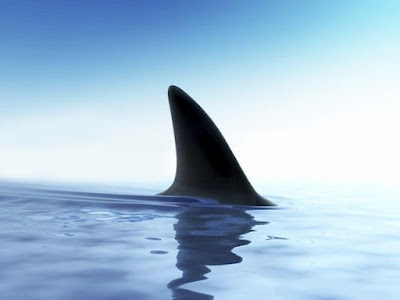When you think of animal life in water, sharks probably come to mind early and often. So let’s start there, and go way back to earlier shark life — an existence that almost vanished forever yet still limited the array of sharks even now.
These days, the worst that can happen to sharks is
overfishing and man-made killings, like finning – the barbaric practice of
catching sharks only to cut off their fins for shark fin soup, then to toss
them back into the ocean. There, the
helpless sharks die of suffocation, blood loss or predation.
“Humans kill 100 million sharks annually,” according to Humane Society International, with hundreds of millions killed for shark fin soup alone. https://tinyurl.com/vehx4pup
About 19 million years ago, long after dinosaurs were
wiped out, sharks nearly went extinct, and even now, they’re still not fully
back. Exactly what happened then is
still not known, but a mysterious mass extinction occurred in the world’s
oceans that decimated sharks’ diversity.
Great white shark NYT image
Scientists studying “dermal denticles,” the
microscopic scales that entirely cover sharks’ bodies like protective armor, found
in sediment cores that shark diversity had so declined that only a fraction of
shark species survived that event.
And now, sharks’ abundance is severely threatened, making for a double whammy that some believe may ultimately amount to the worst extinction of all. https://tinyurl.com/3eyr293m
 |
| Scalloped hammerhead sharks |
One shark expert put it: “A lot of what’s called a shark attack . . . is actually provoked by humans” – plus: the great majority of person-shark meetings don’t involve a bite. So the suggested alternative wording is preferable because it’s less sensational and more accurate. For instance, “shark incident” or shark interaction" or "shark encounter."
This fascinating story includes examples of myriad possible “shark interactions,” including when a person accidentally steps on a tiny one or a passing shark touches a person and keeps going. (Remember, sharks don’t know what humans are!) https://tinyurl.com/3t5adnfp
Time out on sharks for awhile. Maybe later, dogfish sharks and ghost sharks, from
among the more than 500 shark species: small and colossal, glowing and roaming,
according to one source.
Whale shark
On to another watery creature I’ve never seen but recently read about: the cuttlefish. This cephalopod (seh·fuh·luh·paad) has lately become a lab darling for curious (aren’t they all?) scientists. But first,
A cuttlefish is one member of the molluscan class Cephalopoda that also includes squid, octopus and nautilus. These exclusively marine animals are characterized by bilateral body symmetry, a prominent head, and a set of arms or tentacles modified from the primitive molluscan foot. --Wikipedia
Ranging in size from about an inch to more than 2 feet, cuttlefish boast one of the largest brains among invertebrates. They can regenerate their limbs and camouflage, blending with their environment to hunt or escape, and they possess amazing skin that can mimic surrounding textures and colors. These attributes make cuttlefish attractive for exploring how and when intelligence evolves. https://tinyurl.com/3xe3vd8c
 |
| Cuttlefish competing for a female |
Feeling like a nice dip in the ocean about now? Or would “high and dry” be your destination choice?
#
Please comment at 1moreonce.blogspot.com

This is so true! Humans are a much bigger threat to sharks than the sharks are to us.
ReplyDelete